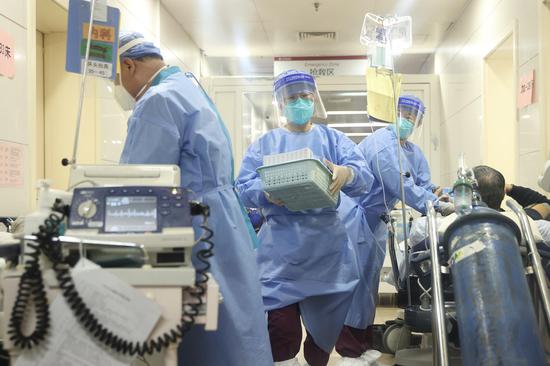
A medical worker in a protective suit adjusts a monitoring device for a patient at the fever clinics of the Third Hospital of Hebei Medical University. (Photo by Wang Zhuangfei/China Daily)
China's recent shifts in COVID-19 control strategy are well-paced, with sufficient preparatory work in place to handle the resulting surge in medical demand, authorities said on Thursday.
With the epidemic progressing rapidly, they added that the country has counted and will always count and publish the COVID-19 death toll in a transparent and fact-based manner.
Wu Zunyou, chief epidemiologist at the Chinese Center for Disease Control and Prevention, said at a news briefing that outbreaks in cities like Beijing and Tianjin as well as Chengdu, Sichuan province, have peaked.
Increased movement during the Spring Festival travel rush and circulation of other respiratory diseases will make the situation more challenging, he said. "Localities are closely monitoring and analyzing outbreaks and strive to reduce disruption to normal lives and production."
China has adjusted its COVID-19 strategy and gradually eased curbs since November, leading to concerns over the challenges posed to the resilience of a healthcare system serving a dense and massive population.
Jiao Yahui, deputy director of the National Health Commission's medical administration bureau, said that the country's overall medical system has not reached full capacity and is not under widespread strain, although some cities have faced a shortage of medical supplies during infection peaks.
"We had foreseen a spike in medical demand (after the policy shift) and have been stepping up preparedness," she said.
For instance, community and rural health institutions have all been required to set up fever clinics, and the number of facilities accepting fever patients at secondary and tertiary hospitals has increased to about 57,000.
"Makeshift hospitals and nucleic acid testing booths can also be repurposed to function as temporary fever clinics, in order to meet the needs of patients," she said.
Authorities have also beefed up production and distribution of medications, and residents can purchase medicines either online or at bricks-and-mortar pharmacies.
Jiao said the number of intensive care beds has reached 181,000 nationwide, and more emergency medical equipment, ranging from respirators to high-flow oxygen devices, has been added.
To alleviate pressure in hard-hit regions, Jiao said a cross-regional assistance mechanism devoted to mobilizing critical care resources has been set up.
As China is set to lift quarantine and testing demands for incoming travelers on Jan 8, Jiao said that being well prepared means that the opening up of borders won't overwhelm its medical system.
The increasingly robust healthcare network is among the factors contributing to changing the country's virus control approach, experts said.
Liang Wannian, head of the commission's COVID-response expert panel, said that China has been closely monitoring the virulence and pathogenicity of the virus, people's immunity level, the capacity of the nation's medical systems and implementation of public health measures.
Since 2020, it has published nine versions of COVID-19 control protocols, and it has launched two new guidelines since November. Starting on Jan 8, the disease will be downgraded from the top Class A to the less serious Class B.
"These shifts have reflected our balanced consideration of different factors… and a continuous effort to enforce more precise and scientific approaches and to concentrate resources to the most significant tasks," he said.
"I think history will prove that our recent adjustments are appropriate, science-based, legitimate and fit the epidemic situation in China," he said.
Liang added that the focus of China's containment work has pivoted to preventing severe cases and deaths, and the country has put great emphasis on researching fatality rates and other perimeters of the virus' threat to people's health.
Regarding counting criteria for COVID-19 death tolls, Jiao, the commission official, said that since 2020, China has always adhered to the method of counting patients who tested positive for the virus and eventually died of respiratory pneumonia caused by the infection.
She said the method is one of the two most common deployed globally.
"While striving to reduce serious cases and deaths, we have provided channels (for hospitals) to report confirmed COVID-19 deaths," she said. "Any COVID-19 death in China will be reported in an open and transparent manner."


















































 京公网安备 11010202009201号
京公网安备 11010202009201号